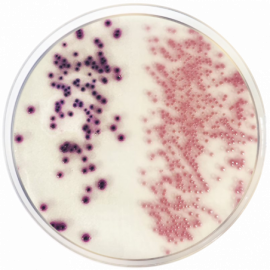Published: 23/09/20 12:38 Categories: Microbiology
One of the parameters most often analyzed in drinking waters is the Escherichia coli / coliforms indicator. But why do we want to enumerate these microorganisms in our bottled water?
Well, the answer is simple and ingenious. The purpose of analyzing these parameters in drinking waters is based on using the presence of this group of microorganisms to determine the potential pathogenicity present in the sample. It would be materially impossible to analyze each microorganism one by one, so the choice is to identify and enumerate the group of coliforms.
But what information does the number of coliforms give us?
Coliforms are ubiquitous bacteria in the environment, whether aquatic, soil or vegetation. But they can also be found, in very large quantities, in the feces of warm-blooded animals.
Furthermore, coliforms do not usually cause serious diseases and are easy to grow, their presence and number can be used as an indicator for the presence of potential pathogenic organisms of fecal origin that may be present in the sample.

So, what's the point of analyzing Escherichia coli?
In earlier protocols and analyses, the enumeration of this bacterium was not included. A simple list of total and fecal coliforms was made. But today, as regulation dictates, it is necessary to analyze the presence of E. coli in drinking waters. This is because, apart from the fact that some pathogenic strains can be found within this species, Escherichia coli is a bacterium belonging to the fecal coliform group. Furthermore, due to its limited survival in non-enteric environments, its presence could suggest that the contamination is of recent origin, enabling the development of more efficient action plans.
CondaChrome®CCA: a solution within everyone's reach
Our agar CondaChrome® agar CCA is formulated with chromogenic substrates that show the presence of coliforms and Escherichia coli, differentiating them in the pigmentation presented by the different colonies.
The β-D-Galactosidase enzyme is active in the coliform group and its presence, by degrading the chromogenic substrate present in the medium, generates pink colonies. Escherichia coli also contains the β-D-Glucoronidase enzyme (which is not present in the rest of the coliforms), which means that the colonies will grow dark blue or purple due to the joint action of both specific enzymatic activities.

Our CondaChrome® CCA medium is formulated according to ISO 9308-1:2004, for the enumeration of Escherichia coli and Coliforms, so you will have no difficulties in incorporating it if you already have an accredited method.
If you need more information about the implementation of the method or about the use of our product, do not hesitate to contact us.

 Food fraud: How do we detect it?
Food fraud: How do we detect it?
 Visit Us at MEDICA 2025 – Discover Our Precise Detection Solutions
Visit Us at MEDICA 2025 – Discover Our Precise Detection Solutions
 PCR: The Technique Revolutionizing Rapid Detection in the Food Industry
PCR: The Technique Revolutionizing Rapid Detection in the Food Industry
 How Culture Media Ensure the Safety, Efficacy, and Quality of Medicines
How Culture Media Ensure the Safety, Efficacy, and Quality of Medicines
 Meeting us at MEDLAB MIDDLE EAST 2025
Meeting us at MEDLAB MIDDLE EAST 2025